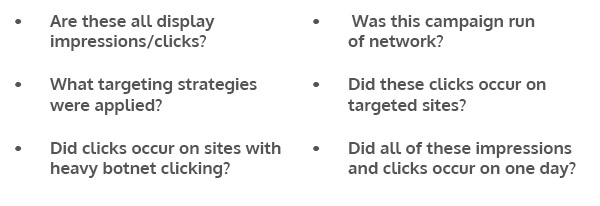Advertising Has a Banking-Industry-Size Fraud Problem
Local advertisers are more susceptible than ever to deceptive digital agency practices. The metric commonly used to gauge success in local display advertising today, click-through rate (CTR), can be easily manipulated to provide the illusion of success, leading local advertisers to believe that their campaign is performing well. Unfortunately, the selective manner in which many […]
Local advertisers are more susceptible than ever to deceptive digital agency practices. The metric commonly used to gauge success in local display advertising today, click-through rate (CTR), can be easily manipulated to provide the illusion of success, leading local advertisers to believe that their campaign is performing well.

Financial Engineering Fraudsters
A common tactic used by some of the largest local online advertising companies is to combine low-performing, run of network (RON) display inventory with mediocre-performing SEM. This is commonly referred to as a display “Awareness Campaign.”
At Vantage Local, we are shocked that many of our clients previously purchased this display “Awareness Campaign,” yet were unaware of the search component and how the targeting was executed. For those who did ask for clarification, they were told that the campaign represented a strong combination of Search and Display, which covered the spectrum of the purchase funnel, from interest to intent. Clever spin, I suppose.
However, this strategy, as it is executed, is rife with chicanery and has the potential to seriously degrade the advertiser’s brand. Below is an example of how this strategy is engineered to best serve the agency, not the advertiser.

Image courtesy of Vantage Local
In this example, the “Awareness Campaign” has an allocated media spend of $500. The agency combines extremely low-cost (0.30¢ CPM) and low-performance (0.02% CTR) brand unsafe display inventory with a mediocre-performing search campaign (1.0% CTR).
By cleverly blending the results of these two inexpensive tactics, the agency produces the illusion of a well-performing local campaign (0.14% CTR). Unfortunately for the advertiser, this is a campaign with no positive benefit that can very likely produce negative effects for the brand. The agency, however, makes out quite well, with an overall CPM of 0.88¢ and a CTR of 0.14%.
By allocating the majority of impressions (500,000) to low-performing display inventory, the agency has significantly lowered their CPM. By combining this with a limited number of mediocre-performing SEM impressions (70,000), and they are able to bring the blended performance up to a deceivingly strong level with only a modest increase in CPM.
This strategy has served the agency well in lowering their overall cost and providing a CTR that enables their Internet marketing consultant to claim positive results.
It is crucial for local advertisers to request that all of their campaigns — be they search or display — be reported independently of one another. Only then will advertisers be able to gauge the true efficacy of their overall strategy.
Fraud-Busting Metrics
Locally-minded advertisers can avoid such fraudulent activities by asking three straightforward questions prior to initiating a display campaign.
The above three questions — if addressed and properly implemented into a campaign — can provide the kind of clean environment that is required for local display campaigns to thrive.
Transparent Reporting
Per above, advertisers are strongly advised to request a reporting breakdown of daily impressions and clicks by site and geography (city).
Site Transparency. With access to daily impressions and clicks per publisher, the advertiser will be able to verify that the majority of their impressions and clicks are not originating from one suspicious site on one given day; rather, they can verify that impressions and clicks are spread out over sites and dates that are consistent with the overall targeting strategy.
In the case of the “Awareness Campaign,” the agency did not provide site transparency by day. Had this been shown in the reporting, the advertiser would see that 700 of the 800 total clicks originated from a limited number of sites used in the SEM campaign.
Geographic Transparency. Access to daily impressions and clicks by geo (city) also serves as a significant safeguard against the type of ad ops wizardry detailed above.
Specifically, transparent city reporting makes it difficult for disingenuous agencies to identify the type of low-value placements on CPC networks that are consistent with their financial model. The agency is forced to identify placements within those specific parameters instead of simply targeting the lowest-cost inventory in the wider geography. Additionally, city reporting provides a second and valuable metric to cross-reference the veracity of site metrics, which should correspond accurately.
Hiding True Performance
At Vantage Local, we frequently undergo comparisons with other agencies based solely on CTR. Unfortunately, the reporting provided by some competing agencies is all-too-often comprised of impressions, clicks and CTR alone.
In Intelligent IP: Revolutionary Ad Targeting For Locally-Minded Marketers, I note that such click-centric reporting creates a breeding ground for the types of fraud such as that in the “Awareness Campaign.” Below is a monthly report from a competitor that Vantage Local received earlier this year. This report exemplifies one form of restricted reporting that prevents identification of fraud.
This form of lump-sum reporting not only fails to provide a daily breakdown of impressions and clicks, but also restricts the advertiser’s access to valuable site and geo reporting. As such, the advertiser is left without answers to the questions below.
Transparent reporting that provides daily impressions and clicks by site and city can address these questions and arm the advertiser with sufficient information to start the optimization process. To prevent agencies from engaging in the financial engineering tactics mentioned above, advertisers are encouraged to ensure that all campaigns provide a daily breakdown of these two metrics.
Engagement/Interaction Rates
Engagement rates represent a crucial component of campaign performance beyond the click. In addition to providing an appropriate gauge of interest by an advertiser’s non-clicking audience, interaction rates can also be used to confirm the accuracy of display reporting.
In the “Awareness Campaign” above, the majority of impressions (500,000 of 570,000) were run as display impressions. With an overall CTR of 0.14%, the advertiser should see an equally impressive engagement rate, particularly if the ad included rich media features, such as in-banner video or an interactive map. However, given that the “Awareness Campaign” was actually run on low-value RON inventory and achieved a low CTR of 0.02%, the advertiser would likely see equally poor performing engagement rates.
The engagement rate provides significant insight into the performance of the display ad beyond the click, especially if that ad incorporates rich media. If the engagement rate is performing at a below average rate when the CTR is above average, the advertiser should question why.
Conclusion
Some of the most prominent and well-funded digital agencies today strategically engineer their display reporting to give the appearance of a strong campaign. Behind the scenes, these agencies use ineffective targeting strategies that are rife with suspicious, ineffective and brand-unsafe impressions and clicks. With the absence of transparent reporting, advertisers are left with incomplete information as to how their media buy was executed and how it truly performed.
In an effort to provide a clean digital environment in which local campaigns may thrive, advertisers must demand transparency in targeting and reporting from their agency. If a campaign is exceeding expectations, it is important to find out how; if a campaign is missing the mark in terms of performance, take a look under the hood and determine why. Regardless of results, advertisers must ask hard questions and demand clear answers from their agencies.
Opinions expressed in this article are those of the guest author and not necessarily MarTech. Staff authors are listed here.
Related stories




